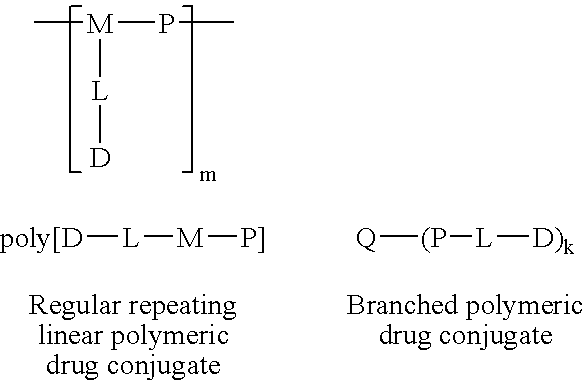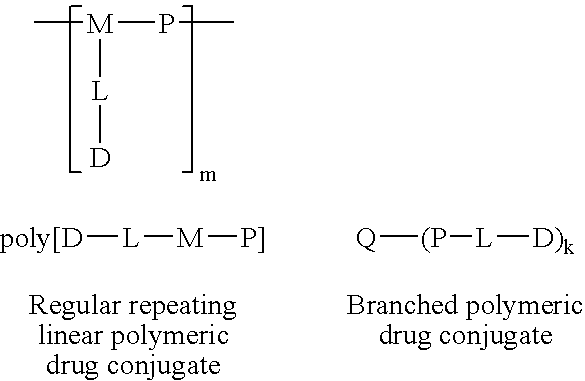Polymeric conjugates for tissue activated drug delivery
a tissue activated, drug technology, applied in the direction of synthetic polymer active ingredients, organic active ingredients, peptide/protein ingredients, etc., can solve the problems of drug bioactivity, drug bioactivity, etc., to improve drug solubility, drug bioavailability, and drug bioactivity.
- Summary
- Abstract
- Description
- Claims
- Application Information
AI Technical Summary
Benefits of technology
Problems solved by technology
Method used
Image
Examples
Embodiment Construction
[0034] The present invention describes polymeric drug conjugates formed by covalently attaching a biologically active agent to a co-polymeric backbone via an enzymatically cleavable linker. The linker consists of chemical chains with one or more bonds that are susceptible to physiological cleavage, preferably enzymatic cleavage. The conjugates are administered to a patient, wherein the biologically active agent is released from the polymer backbone by a physiological process, and the biological agent's activity is reconstituted. The pharmaceutical agent released from the polymer / linking agent conjugate by metabolic activity provides reconstituted pharmaceutical activity in high concentrations at a specific tissue location.
[0035] The general structure of preferred constructs according to the present invention are shown below.
[0036] 5.1 Polymeric Drug Conjugate Formulas 2
[0037] Construct Formula poly[D-L-M-P]
[0038] The polymer construct of formula poly[D-L-M-P] consists of a multifunc...
PUM
| Property | Measurement | Unit |
|---|---|---|
| pH | aaaaa | aaaaa |
| pH | aaaaa | aaaaa |
| volume | aaaaa | aaaaa |
Abstract
Description
Claims
Application Information
 Login to View More
Login to View More - R&D
- Intellectual Property
- Life Sciences
- Materials
- Tech Scout
- Unparalleled Data Quality
- Higher Quality Content
- 60% Fewer Hallucinations
Browse by: Latest US Patents, China's latest patents, Technical Efficacy Thesaurus, Application Domain, Technology Topic, Popular Technical Reports.
© 2025 PatSnap. All rights reserved.Legal|Privacy policy|Modern Slavery Act Transparency Statement|Sitemap|About US| Contact US: help@patsnap.com



